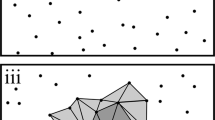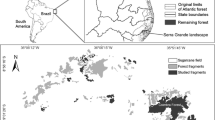Abstract
The nucleation hypothesis appears to explain widespread patterns of succession in tropical pastures, specifically the tendency for isolated trees to promote woody species recruitment. Still, the nucleation hypothesis has usually been tested explicitly for only short durations and in some cases isolated trees fail to promote woody recruitment. Moreover, at times, nucleation occurs in other key habitat patches. Thus, we propose an extension, the matrix discontinuity hypothesis: woody colonization will occur in focal patches that function to mitigate the herbaceous vegetation effects, thus providing safe sites or regeneration niches. We tested predictions of the classical nucleation hypothesis, the matrix discontinuity hypothesis, and a distance from forest edge hypothesis, in five abandoned pastures in Costa Rica, across the first 11 years of succession. Our findings confirmed the matrix discontinuity hypothesis: specifically, rotting logs and steep slopes significantly enhanced woody colonization. Surprisingly, isolated trees did not consistently significantly enhance recruitment; only larger trees did so. Finally, woody recruitment consistently decreased with distance from forest. Our results as well as results from others suggest that the nucleation hypothesis needs to be broadened beyond its historical focus on isolated trees or patches; the matrix discontinuity hypothesis focuses attention on a suite of key patch types or microsites that promote woody species recruitment. We argue that any habitat discontinuities that ameliorate the inhibition by dense graminoid layers will be foci for recruitment. Such patches could easily be manipulated to speed the transition of pastures to closed canopy forests.





Similar content being viewed by others
References
Aide TM, Cavelier J (1994) Barriers to tropical lowland forest restoration in the Sierra Nevada de Santa Marta, Colombia. Restor Ecol 2:219–229
Albornoz FE, Gaxiola A, Seaman BJ, Pugnaire FI, Armesto JJ (2013) Nucleation-driven regeneration promotes post-fire recovery in a Chilean temperate forest. Plant Ecol 214:765–776
Callaway RM (2007) Positive interactions and interdependence in plant communities. Springer, Berlin Heidelberg New York
Carlucci MB, Duarte LD, Pillar VD (2011) Nurse rocks influence forest expansion over native grassland in southern Brazil. J Veg Sci 22:111–119
Carpenter FL, Palacios Mayorga S, Gonzalez Quintero E, Schroeder M (2001) Land use and erosion of a Costa Rican Ultisol affect soil chemistry, mycorrhizal fungi and early regeneration. Forest Ecol Manag 144:1–17
Carriere SM, Andre M, Letourmy P, Olivier I, McKey DB (2002a) Seed rain beneath remnant trees in a slash-and-burn agricultural system in southern Cameroon. J Trop Ecol 18:353–374
Carriere SM, Letourmy P, McKey DB (2002b) Effects of remnant trees in fallows on diversity and structure of forest regrowth in a slash-and-burn agricultural system in southern Cameroon. J Trop Ecol 18:375–396
Carson WP, Peterson CJ (1990) The role of litter in an old-field community: impact of litter quantity in different seasons on plant species richness and abundance. Oecologia 85:8–13
Connell JH, Slatyer RO (1977) Mechanism of succession in natural communities and their role in community stability and organization. Am Nat 11:1119–1144
Corbin JD, Holl KD (2012) Applied nucleation as a forest restoration strategy. Forest Ecol Manag 265:37–46
Cubiña A, Aide TM (2001) The effect of distance from forest edge on seed rain and soil seed bank in a tropical pasture. Biotropica 33:260–267
Dale MRT (1999) Spatial pattern analysis in plant ecology. Cambridge Univ Press, New York
Dosch JJ, Peterson CJ, Haines BL (2007) Seed rain during initial colonization of abandoned pastures in the premontane wet forest zone of southern Costa Rica. J Trop Ecol 23:151–159
Duncan RS, Chapman CA (1999) Seed dispersal and potential forest succession in abandoned agriculture in tropical Africa. Ecol Appl 9:998–1008
Duncan RS, Duncan VE (2000) Forest succession and distance from forest edge in an Afro-tropical grassland. Biotropica 32:33–41
Ferguson BG, Vandermeer J, Morales H, Griffith DM (2003) Post-agricultural succession in El Peten, Guatemala. Conserv Biol 17:818–828
Goldberg DE, Gross KL (1988) Disturbance regimes of mid successional old fields. Ecology 69:1677–1688
Grubb PJ (1977) The maintenance of species-richness in plant communities: the importance of the regeneration niche. Biol Rev 52:107–145
Guevara S, Purata SE, Van der Maarel E (1986) The role of remnant forest trees in tropical secondary succession. Vegetatio 66:74–84
Guevara S, Laborde J, Sanchez-Rios G (2004) Rain forest regeneration beneath the canopy of fig trees isolated in pastures of Las Tuxtlas, Mexico. Biotropica 36:99–108
Harmon ME, Franklin JF (1989) Tree seedlings on logs in Picea-Tsuga forests of Oregon and Washington. Ecology 70:48–59
Hartshorn GS (1983) Plants: introduction. In: Janzen DH (ed) Costa Rican natural history. University of Chicago Press, Chicago, pp 118–157
Harvey CA, Haber WA (1998) Remnant trees and the conservation of biodiversity in Costa Rican pastures. Agrofor Syst 44:37–68
Holl KD (2002) Effect of shrubs on tree seedling establishment in an abandoned tropical pasture. J Ecol 90:179–187
Holl KD (2007) Old field vegetation succession in the Neotropics. In: Cramer VA, Hobbs RJ (eds) Old fields: dynamics and restoration of abandoned Farmland. Island Press, Washington, DC, pp 93–118
Holl KD, Lulow ME (1997) Effects of species, habitat, and distance from edge on post-dispersal seed predation in a tropical rainforest. Biotropica 29:459–468
Holl KD, Loik ME, Lin EHV, Samuels IA (2000) Tropical montane forest restoration in Costa Rica: overcoming barriers to dispersal and establishment. Restor Ecol 8:339–349
Holl KD, Zahawi RA, Cole RJ, Ostertag R, Cordell S (2011) Planting seedlings in tree islands versus plantations as a large-scale tropical forest restoration strategy. Restor Ecol 19:470–479
Hooper E, Legendre P, Condit R (2004) Factors affecting community composition of forest regeneration in deforested, abandoned land in Panama. Ecology 85:3313–3326
Hooper E, Legendre P, Condit R (2005) Barriers to forest regeneration of deforested and abandoned land in Panama. J Appl Ecol 42:1165–1174
Jin VL, West LT, Haines BL, Peterson CJ (2001) P retention in tropical pre-montane soils across forest-pasture interfaces. Soil Sci 165:881–889
Juarez J (1994) A GIS assessment of deforestation in the Coto Brus Valley of Costa Rica. M.S. thesis, Oklahoma State University, Stillwater
Kareiva PM, Bertness MD (1997) Re-examining the role of positive interactions in communities. Ecology 78:1945
Lacerda F, Miranda I, Kato OR, Bispo CJC, Vale ID (2013) Weed dynamics during the change of a degraded pasture to agroforestry system. Agrofor Syst 87:909–916
Martínez-Garza C, González-Montagut R (1999) Seed rain from forest fragments into tropical pastures in Los Tuxtlas, Mexico. Plant Ecol 145:255–265
Mesquita RCG, Ickes K, Ganade G, Williamson GB (2001) Alternative successional pathways in the Amazon Basin. J Ecol 89:528–537
Metcalfe DJ, Grubb PJ, Turner IM (1998) The ecology of very small-seeded shade-tolerant trees and shrubs in lowland rain forest in Singapore. Plant Ecol 134:131–149
Myster RW (2003) Vegetation dynamics of a permanent pasture plot in Puerto Rico. Biotropica 35:422–428
Myster RW (2004) Post-agricultural invasion, establishment, and growth of Neotropical trees. Bot Rev 70:381–402
Myster RW, Pickett STA (1992) Effect of palatability and dispersal mode on spatial patterns of trees in oldfields. Bull Torre Bot Club 119:145–151
Nakashizuka T (1989) Role of uprooting in composition and dynamics of an old-growth forest in Japan. Ecology 70:1273–1278
Nepstad D, Uhl C, Pereira CA, Da Silva JMC (1996) A comparative study of tree establishment in abandoned pasture and mature forest of eastern Amazonia. Oikos 76:25–39
Nuttle T, Haefner JW (2005) Seed dispersal in heterogeneous environments: bridging the gap between mechanistic dispersal and forest dynamics models. Am Nat 165:336–349
Odum EP (1969) The strategy of ecosystem development. Science 164:262–270
Perry GLW (2004) SpPack: spatial point pattern analysis in Excel using Visual Basic for Applications. Environ Mod Soft 19:559–569
Peterson CJ, Carson WP (2008) Processes constraining woody species succession on abandoned pastures in the tropics: on the relevance of temperate theories of succession. In: Carson WP, Schnitzer SA (eds) Tropical forest community ecology. Blackwell Publishing, Oxford, pp 367–390
Peterson CJ, Haines BL (2000) Early successional patterns and potential facilitation of woody plant colonization by rotting logs in premontane Costa Rican pastures. Restor Ecol 8:361–369
Peterson CJ, Squires ER (1995) An unexpected change in spatial pattern across 10 years in an aspen-white pine forest. J Ecol 83:847–855
Pickett STA, White PS (1985) Patch dynamics: a synthesis. In: Pickett STA, White PS (eds) The ecology of natural disturbance and patch dynamics. Academic Press, New York, pp 371–385
Pickett STA, Collins SL, Armesto JJ (1987) Models, mechanisms and pathways of succession. Bot Rev 53:335–371
Reid JL, Holl KD (2013) Arrival ≠ survival. Restor Ecol 21:153–155
Reis A, Bechara FC, Tres DR (2010) Nucleation in tropical ecological restoration. Sci Agric 67:244–250
Royo AA, Carson WP (2006) On the formation of dense understory layers in forests worldwide: consequences and implications for forests dynamics, biodiversity, and succession. Can J For Res 36:1345–1362
Schlawin J, Zahawi RA (2008) ‘Nucleating’ succession in recovering Neotropical wet forests: the legacy of remnant trees. J Veg Sci 19:485–492
Slocum MG (2000) Logs and fern patches as recruitment foci in a tropical pasture. Restor Ecol 8:408–413
Slocum MG (2001) How tree species differ as recruitment foci in a tropical pasture. Ecology 82:2547–2559
Slocum MG, Horvitz CC (2000) Seed arrival under different genera of trees in a Neotropical pasture. Plant Ecol 149:51–62
Tilman D (1985) The resource-ratio hypothesis of plant succession. Am Nat 125:827–852
Toh I, Gillespie M, Lamb D (1999) The role of isolated trees in facilitating tree seedling recruitment at a degraded sub-tropical rainforest site. Restor Ecol 7:288–297
Uhl C, Clark H, Clark K, Maquirino P (1982) Successional patterns associated with slash-and-burn agriculture in the upper Rio Negro region of the Amazon Basin. Biotropica 14:249–254
Vieira ICG, Uhl C, Nepstad D (1994) The role of the shrub Cordia multispicata Cham. as a “succession facilitator” in an abandoned pasture, Paragominas, Amazonia. Vegetatio 115:91–99
Wilding LP, Smeck NE, Hall GF (1983) Pedogenesis and soil taxonomy: the soil orders. Elsevier Science Publishers B.V, Amsterdam
Yarranton GA, Morrison RG (1974) Spatial dynamics of a primary succession: nucleation. J Ecol 62:417–428
Zahawi RA, Augspurger CK (2006) Tropical forest restoration: tree islands as recruitment foci in degraded lands of Honduras. Ecol Appl 16:464–478
Zahawi RA, Holl KD (2009) Comparing the performance of tree stakes and seedlings to restore abandoned tropical pastures. Restor Ecol 17:854–864
Zahawi RA, Holl KD, Cole RJ, Reid JL (2013) Testing applied nucleation as a strategy to facilitate tropical forest recovery. J Appl Ecol 50:88–96
Zanne AE, Chapman CA (2001) Expediting reforestation in tropical grasslands: distance and isolation from seed sources in plantations. Ecol Appl 11:1610–1621
Acknowledgments
The first several years of this study were funded by National Science Foundation Grant 94-24606. For grueling initial work to install fencing, we thank Miguel Solera, John Paul Davis, Gordon Ward, and Audrey Sanyi. For assistance with the surveys, we thank Ronal Murillo, Eric Quesada, Gordon Ward, Andy Jones, Steve Franks, Todd Kelly, Kevin and Heidi Spradlin, and Augusta West. Thanks to Luis Diego Gomez, Zak Zahawi, and the staff of the Las Cruces Biological Station for logistical help. The experiments reported here comply with the current laws of Costa Rica, in which the research was performed. J.D.’s participation in this work was made possible by a Faculty Research Grant from Macalester College. The first author wishes to dedicate this paper to the memory of late collaborator and friend, Bruce Haines, who died in February 2007.
Author information
Authors and Affiliations
Corresponding author
Additional information
Communicated by Juan J. Armesto.
Electronic supplementary material
Below is the link to the electronic supplementary material.
Rights and permissions
About this article
Cite this article
Peterson, C.J., Dosch, J.J. & Carson, W.P. Pasture succession in the Neotropics: extending the nucleation hypothesis into a matrix discontinuity hypothesis. Oecologia 175, 1325–1335 (2014). https://doi.org/10.1007/s00442-014-2986-7
Received:
Accepted:
Published:
Issue Date:
DOI: https://doi.org/10.1007/s00442-014-2986-7




